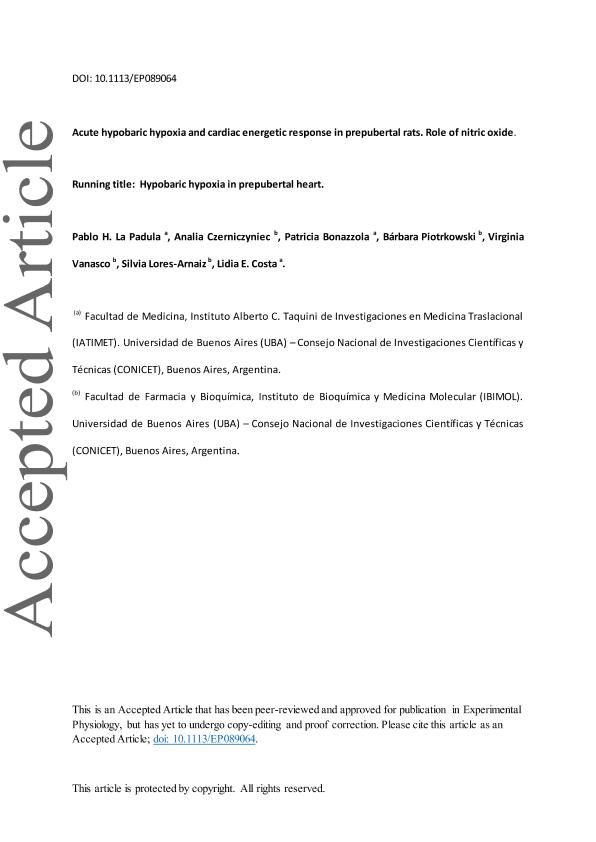Artículo
Acute hypobaric hypoxia and cardiac energetic response in prepubertal rats: role of nitric oxide
la Padula, Pablo Hugo; Czerniczyniec, Analia ; Bonazzola, Patricia
; Bonazzola, Patricia ; Piotrkowski, Barbara
; Piotrkowski, Barbara ; Vanasco, Virginia
; Vanasco, Virginia ; Lores Arnaiz, Silvia
; Lores Arnaiz, Silvia ; Costa, Lidia Esther
; Costa, Lidia Esther
 ; Bonazzola, Patricia
; Bonazzola, Patricia ; Piotrkowski, Barbara
; Piotrkowski, Barbara ; Vanasco, Virginia
; Vanasco, Virginia ; Lores Arnaiz, Silvia
; Lores Arnaiz, Silvia ; Costa, Lidia Esther
; Costa, Lidia Esther
Fecha de publicación:
03/2021
Editorial:
Wiley Blackwell Publishing, Inc
Revista:
Experimental Physiology
ISSN:
0958-0670
Idioma:
Inglés
Tipo de recurso:
Artículo publicado
Clasificación temática:
Resumen
New Findings: What is the central question of this study? In adult rat hearts, exposure to hypobaric hypoxia increases tolerance to hypoxia–reoxygenation, termed endogenous cardioprotection. The mechanism involves the nitric oxide system and modulation of mitochondrial oxygen consumption. What is the cardiac energetic response in prepubertal rats exposed to hypobaric hypoxia? What is the main finding and its importance? Prepubertal rats, unlike adult rats, did not increase tolerance to hypoxia–reoxygenation in response acute exposure to hypobaric hypoxia, which impaired cardiac contractile economy. This finding could be related to a failure to increase nitric oxide synthase expression, hence modulation of mitochondrial oxygen consumption and ATP production. Abstract: Studies in our laboratory showed that exposure of rats to hypobaric hypoxia (HH) increased the tolerance of the heart to hypoxia–reoxygenation (H/R), involving mitochondrial and cytosolic nitric oxide synthase (NOS) systems. The objective of the present study was to evaluate how the degree of somatic maturation could alter this healthy response. Prepubertal male rats were exposed for 48 h to a simulated altitude of 4400 m in a hypobaric chamber. The mechanical energetic activity in perfused hearts and the contractile functional capacity of NOS in isolated left ventricular papillary muscles were evaluated during H/R. Cytosolic nitric oxide (NO), production of nitrites/nitrates (Nx), expression of NOS isoforms, mitochondrial O2 consumption and ATP production were also evaluated. The left ventricular pressure during H/R was not improved by HH. However, the energetic activity was increased. Thus, the contractile economy (left ventricular pressure/energetic activity) decreased in HH. Nitric oxide did not modify papillary muscle contractility after H/R. Cytosolic p-eNOS-Ser1177 and inducible NOS expression were decreased by HH, but no changes were observed in NO production. Interestingly, HH increased Nx levels, but O2 consumption and ATP production in mitochondria were not affected by HH. Prepubertal rats exposed to HH preserved cardiac contractile function, but with a high energetic cost, modifying contractile economy. Although this could be related to the decreased NOS expression detected, cytosolic NO production was preserved, maybe through the Nx metabolic pathway, without modification of mitochondrial ATP production and O2 consumption. In this scenario, the treatment was unable to increase tolerance to H/R as observed in adult animals.
Archivos asociados
Licencia
Identificadores
Colecciones
Articulos (IATIMET)
Articulos de INSTITUTO ALBERTO C. TAQUINI DE INVESTIGACIONES EN MEDICINA TRASLACIONAL
Articulos de INSTITUTO ALBERTO C. TAQUINI DE INVESTIGACIONES EN MEDICINA TRASLACIONAL
Articulos(IBIMOL)
Articulos de INSTITUTO DE BIOQUIMICA Y MEDICINA MOLECULAR
Articulos de INSTITUTO DE BIOQUIMICA Y MEDICINA MOLECULAR
Citación
la Padula, Pablo Hugo; Czerniczyniec, Analia; Bonazzola, Patricia; Piotrkowski, Barbara; Vanasco, Virginia; et al.; Acute hypobaric hypoxia and cardiac energetic response in prepubertal rats: role of nitric oxide; Wiley Blackwell Publishing, Inc; Experimental Physiology; 106; 5; 3-2021; 1235-1248
Compartir
Altmétricas



